Setting up Realtime Video I/O
hiSince Reality Processing Engine is node-based, SDI devices, video input, and outputs are also represented as nodes. There is not a separate video I/O configuration tool. Each Virtual Set configuration file also has its own video I/O settings for each engine.
Supported SDI Video Boards
Reality Engine currently supports the following SDI I/O boards:
Please keep that in mind: AJA cards differ from each other in terms of the PCI, BNC connectors styles, and fan options. Choosing fanless Corvid boards will require a very efficient cooling environment. You may want to consider a Corvid with an onboard fan option.
AJA Kona 5 board is supported only as experimental.
AJA Device Node
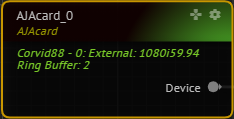
This node represents a physical PCI-e AJA video board to the node graph. It supports to define up to 4 video boards. The device node detects the video boards reference source and video mode along with the input SDI signals.
AJA Device Settings
In order to setup an AJA video device, you should setup DeviceID, Reference and RingBufferSize properties:
DeviceID: The video board name you want to use. In one system, up to 4 AJA Corvid boards can be listed.Reference: You have to mention what your reference sync source is coming from. It is recommended that you use an “External” sync source. But for some setups, you can lock your AJA output to anyone of your SDI input timing.RingBufferSize: This property defines how many frames should be buffered when doing video output when using this device.
Increasing the RingBufferSize will also increase latency. But if you can afford the latency, your short period performance drops won’t likely drop frames on video output. By default, the ring buffer size is 2 frames, but you can go as low as 1 frame. However, 1 frame means that we are doing synced rendering. So, each and every frame has to be rendered and output under one frame duration.
AJA Card Channel Status
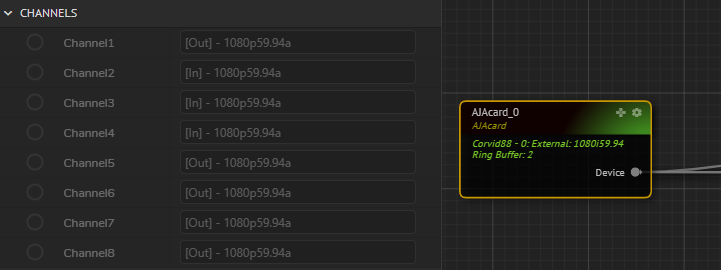
Each AJAcard node monitors all of its channels. Each channel represents one BNC on the board. Each channel of the Corvid board(s) can be configured either as input or output.
AJA Card Info

AJAcard node detects currently installed Device Version, Driver Version, Serial Number and Firmware installed on the card. This information might be useful for technical support purposes. Each AJAcard node will be allowed to configure only one device at a time. There are is chance to select same device for multiple times.

Input Video Bit Depth

AJAin node supports either 8-bit or 10-bit video input modes. You can choose between precision on Pixel Format property. 10-bit video mode gives you better precision but will cost you slightly more performance.
Input Video Delay
Delay works in fields when inputting an interlaced video format, works in frames when inputting progressive video. The delay setting is necessary for syncing track devices with video inputs from the tracked cameras.
Input Video Signal Range
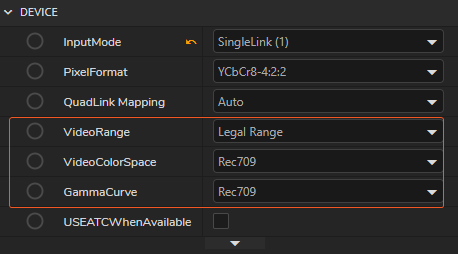
You can choose between Legal Range and Full Range modes. Here are the ranges for 8-bit luma values:
- Legal Range: [16 – 235]
- Full Range: [0 – 255]
Some cameras may send full-range video signals. In such cases, you can get extra details in black and white levels when you use the “Full Range” video mode.
Color Space

The input color space when converting YCbCr values to RGB. Here are the supported color spaces:
- Rec 601: SD NTSC/PAL
- Rec 709: HDTV
- Rec 2020: UHDTV
Chroma Filtering 4:2:2 Signal Input
4:2:2 YCbCr video signals chroma have only half resolution of the luminance values. Any computer has to filter the chroma signal before converting it to RGB values. This chroma filtering step is vital for any keyer to achieve good results.
Reality Video Input nodes use a method called luminance weighted chroma filtering, which helps improve the filtered chroma resolution.
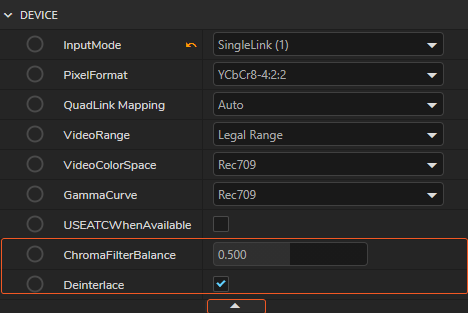
By default, chroma filter samples the left and right samples with 0.5 weight. If we set the balance to 0.0, it will use completely left pixels. If we set it to 1.0, it will use completely right pixels. This setting is in the advanced menu of “Device” settings. You have to click the advanced button, which is shown with a triangle-shaped icon in order to bring these parameters.
AJA Input Fallback
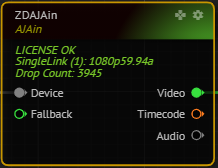
AJAin has a Fallback input, where you can connect to another AJAin node or an image as a fallback. So, in case the signal in the input is lost, the node is going to bypass its fallback input.
AJA Timecode
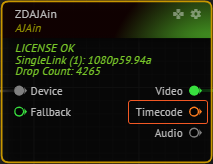
The TimeCode pin should always be connected to EngineControl and Tracking nodes to send its own timecode data to both tracking and engine to match the frames. You can see the detail of the data sent from AJA to other devices under this node's properties:

AJA Output Node
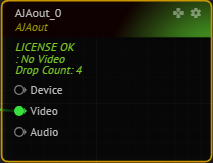
This node outputs video from the node graph to SDI video boards. Just like the AJAIN node, the AJAout node needs to know from which pin from AJA Video Card signal is coming from, and this can be edited by OutputMode. You can set the output VideoFormat, PixelFormat, VideoRange and ColorSpace just like the AJAin node. \
AJAout node also supports RGB to YCbCr 4:2:2 filtering. The same CHROMA FILTER BALANCE as the AJAin node also applies to the output node.
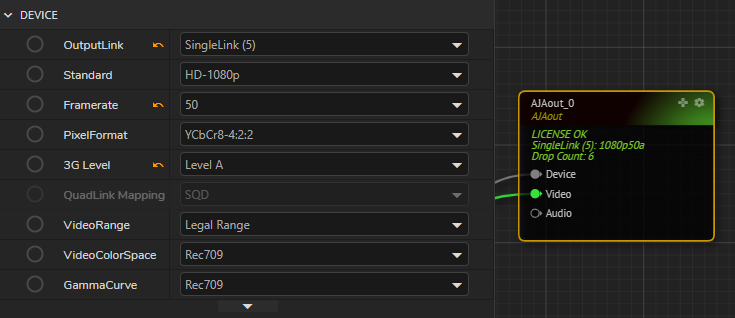
AJA output node properties are now exposed based on output STANDARDS, FRAMERATE and PIXEL FORMAT selections. This will ensure proper settings are selected for that device and only technically possible hardware combination is available to avoid any glitches and incompatibility.


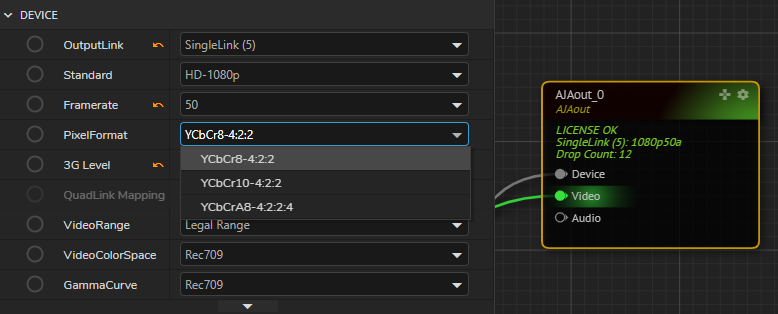
Setting Interlaced Output Format in Corvid 44 12G BNC
Unlike AJA Corvid 44 and Corvid 88, Corvid 44 12G BNC cards requires additional settings to set video output format to interlaced signal.
Follow instructions below for this settings:
Interlace format must be set on AJAout node.

Select AJAout node and expand the advanced properties arrow as shown in the image above. Now set ReverseFields property to True.
Interlace format will not be achieved while this property is False